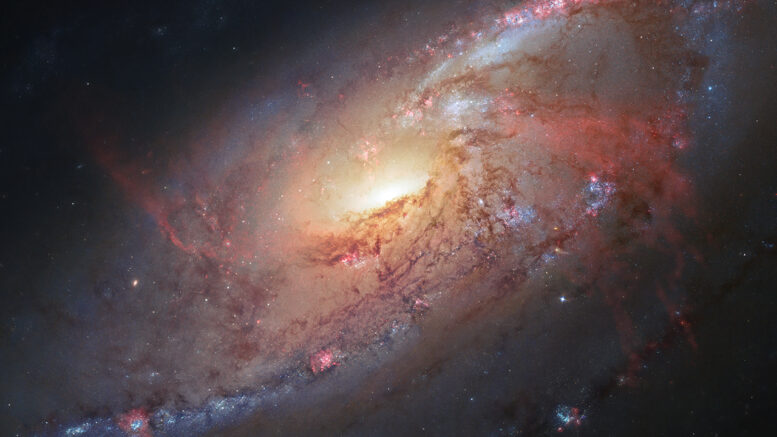Messier 106 is a spiral galaxy located in the constellation Canes Venatici, the Hunting Dogs. It is similar in size and luminosity to the Andromeda Galaxy (M31) and is one of the brightest, largest nearby galaxies. Messier 106 is classified as a SABbc type galaxy, which means that it is an intermediate between a normal and barred spiral galaxy. It is home to at least 400 billion stars.
Messier 106 is also classified as a Seyfert II galaxy. It has a considerably larger extent in radio than in visible light and exhibits emission line spectra from the nucleus. M106 shows unusual emission lines and X-rays, indicating that a portion of the galaxy is falling into a central supermassive black hole.
| Description | |
| Visible From Pacific Northwest | January to June |
| Best Time To Observe | January, and February |
| Minimum Size Of Viewing Device | Binoculars |
| Object Type | Spiral Galaxy |
| Designations | Messier 106, M106, NGC 4258, PGC 39600, UGC 7353, 2MASX J12185761+4718133, MCG+08-22-104, B3 1216+475, GB1 1216+476, 87GB 121625.0+473537, PBC J1218.9+4718, RX J1219.0+4717, RX J1218.9+4718, 1RXS J121900.4+471747, SDSS J121857.50+471814.3, SWIFT J1219.4+4720, SWIFT J1219.0+4715, VV 448, UZC J121857.7+471820, XSS J12190+4715, Z 243-67, Z 244-3, Z 1216.5+4735 |
| Right Ascension | 12h 18m 57.5s |
| Declination | +47°18’14” |
| Constellation | Canes Venatici |
| Number Of Stars | 400 billion |
| Apparent magnitude | +9.1 |
| Apparent dimensions | 18′.6 x 7′.2 |
| Object Radius | 67,500 light years |
| Distance From Earth | 23,700,000 light years |
History
Messier 106 was discovered by the French astronomer Pierre Méchain in July of 1781. Méchain mentioned the discovery in a letter to Johann Bernoulli dated May 6, 1783:
In July 1781 I found another nebula close to the Great Bear near the star No. 3 of the Hunting Dogs and 1 deg more south, I estimate its right ascension 181d 40′ and its northern declination about 49d. I will be going to determine the more accurate position of this one shortly.
Pierre Méchain
The galaxy, however, was not included in the Messier Catalogue until 1947, when Helen Sawyer Hogg added it along with M105 and M107 based on Méchain’s letter.
William Herschel independently discovered M106 on March 9, 1788 and catalogued it as H V.43.
John Herschel catalogued the object as h 1175 in 1833 and later included it in the General Catalogue as GC 2841. He described it as “very bright; very large; very much extended in position angle 0 degrees; suddenly much brighter toward the middle where there is a nucleus.”
Two supernovae have been discovered in M106. SN 1981K, discovered in 1981, reached 16th magnitude and SN 2014bc, detected on May 20, 2014 at magnitude 14.8, was classified as a Type II supernova.
Locating M106 In The Sky
Messier 106 lies along a line drawn from Phecda (Phad), Gamma Ursae Majoris, the star marking the bottom of the Big Dipper toward the handle, to Cor Caroli, Alpha Canum Venaticorum, the brightest star in Canes Venatici constellation. M106 can also be located by extending the line from Dubhe, Alpha Ursae Majoris to Phecda. Dubhe is the northern of the Pointer Stars, the two stars of the Big Dipper that point the way to Polaris in Ursa Minor.
Messier 106 can also be found using Megrez, Delta Ursae Majoris, the faintest star of the Big Dipper asterism, which connects the Dipper’s bowl to the handle. The magnitude 4.8 star 5 Canum Venaticorum (5 CVn) lies 5.5 degrees south and a little east of Megrez and M106 is positioned a little over 4 degrees to the south of 5 CVn. The best time of year to observe M106 is during the spring. The galaxy is a challenging object for southern observers because it never rises very high in the sky.

Viewing M106
M106 has a high surface brightness and can be seen in binoculars, which reveal a faint patch of light. Small telescopes show a diffuse patch with a brighter centre, while 8-inch telescopes reveal more details of the galaxy’s structure. Large amateur telescopes show the galaxy’s spiral arms.
Photographing M106
Although Messier 106 lacks a cool name such as the Cats Eye Galaxy for Orioon Nebula, that doesn’t mean Messier 106 should get less attention from astrophotographers.
Using several filters including luminance, red, green, blue, and Hydrogen Alpha, one can get a great image using these filters and a telescope of at least 8 inches in aperture to obtain a great amount of detail in the galaxy. If there is an Bortle zone, a great amount of detail will be able to be obtained in the galaxy. Autoguiding is a big help here as is gathering at least 3 two 4 hours of exposures.
Sources And Further Reading
Descriptions of all of Messier Objects can be found here.
https://freestarcharts.com/messier-106
https://www.nasa.gov/feature/goddard/2017/messier-106
http://www.messier.seds.org/m/m106.html

Be the first to comment on "Messier 106"